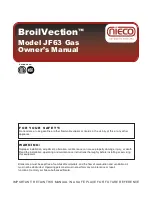
30
14 - GENERAL MAINTENANCE AND CARE INSTRUCTIONS
Figure 14-3 - Gas Burner Flame
Figure 14-2 - Gas Burner Pilot
Figure 14-1 - Burner Tray
BURNERS
ORIFICES
GAS VALVE
•
Visually inspect main burner and pilot flames at start of
heating season and again in mid-season.
◊ Main burner flame should have well defined inner blue
mantel with lighter blue outer mantel.
◊ Check burner throats and burner orifices for lint or
dust obstruction. Figures 14-1 and 14-3.
•
Pilot flame should envelop ⅜ to ½ inch of tip of ignition/
sensing electrode. See Figure 14-2.
•
To adjust pilot flame: remove pilot adjustment
cover screw and turn inner adjustment screw
counterclockwise
to increase or clockwise
to decrease pilot flame. Replace cover screw after
adjustment to prevent possible gas leakage. See
Figure 12-1, Page 27.
• Check burners and pilot for signs of corrosion, rust or
scale buildup.
• Area around boiler shall be clear and free of
combustible materials, gasoline and other flammable
vapors and liquids.
•
Free flow of combustion and ventilating air to boiler and
boiler room shall not be restricted or blocked.
•
Inspect factory supplied and field sourced low water
cutoffs annually, or as recommended by low water
cutoff manufacturer. Flush float type low water cutoffs
per manufacturer's instructions.
• Contact a
Qualified Service Agency
to make
annual inspection of boiler and heating system.
This should include:
1.
Check casting and vent for signs of corrosion from
condensate.
2.
Examine pilot lint screen and clean if needed.
3.
Check venting for any signs of corrosion, rust,
damage or deterioration. Contact a
Qualified
Service Agency
immediately if you observe any of
these conditions.
4.
Clean oxidation on igniter/flame sensor with abrasive
cloth as needed.
14.3 General Maintenance
INNER BLUE
MANTEL
LIGHT BLUE
OUTER MANTEL
3/8" to 1/2 "
(9.5 to 12.7mm)
PILOT LINT
SCREEN
Proper Flame
Adjustment
Shown
PN 240012807, Rev. C [11/15/2020]















































